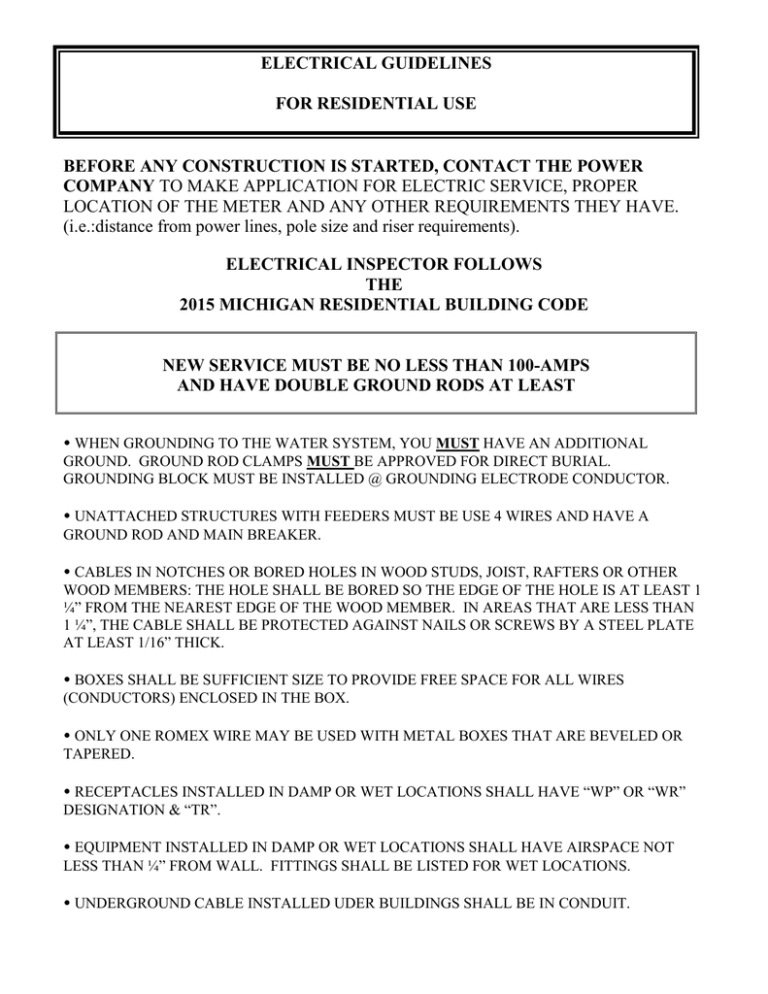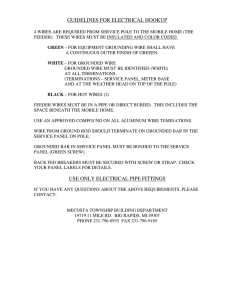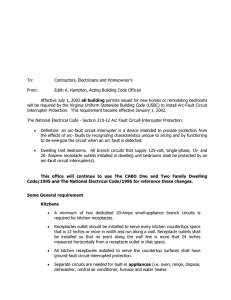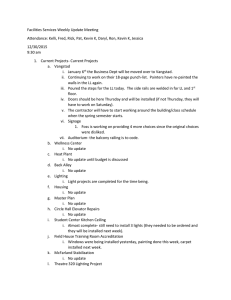electrical guidelines
advertisement

ELECTRICAL GUIDELINES FOR RESIDENTIAL USE BEFORE ANY CONSTRUCTION IS STARTED, CONTACT THE POWER COMPANY TO MAKE APPLICATION FOR ELECTRIC SERVICE, PROPER LOCATION OF THE METER AND ANY OTHER REQUIREMENTS THEY HAVE. (i.e.:distance from power lines, pole size and riser requirements). ELECTRICAL INSPECTOR FOLLOWS THE 2015 MICHIGAN RESIDENTIAL BUILDING CODE NEW SERVICE MUST BE NO LESS THAN 100-AMPS AND HAVE DOUBLE GROUND RODS AT LEAST • WHEN GROUNDING TO THE WATER SYSTEM, YOU MUST HAVE AN ADDITIONAL GROUND. GROUND ROD CLAMPS MUST BE APPROVED FOR DIRECT BURIAL. GROUNDING BLOCK MUST BE INSTALLED @ GROUNDING ELECTRODE CONDUCTOR. • UNATTACHED STRUCTURES WITH FEEDERS MUST BE USE 4 WIRES AND HAVE A GROUND ROD AND MAIN BREAKER. • CABLES IN NOTCHES OR BORED HOLES IN WOOD STUDS, JOIST, RAFTERS OR OTHER WOOD MEMBERS: THE HOLE SHALL BE BORED SO THE EDGE OF THE HOLE IS AT LEAST 1 ¼” FROM THE NEAREST EDGE OF THE WOOD MEMBER. IN AREAS THAT ARE LESS THAN 1 ¼”, THE CABLE SHALL BE PROTECTED AGAINST NAILS OR SCREWS BY A STEEL PLATE AT LEAST 1/16” THICK. • BOXES SHALL BE SUFFICIENT SIZE TO PROVIDE FREE SPACE FOR ALL WIRES (CONDUCTORS) ENCLOSED IN THE BOX. • ONLY ONE ROMEX WIRE MAY BE USED WITH METAL BOXES THAT ARE BEVELED OR TAPERED. • RECEPTACLES INSTALLED IN DAMP OR WET LOCATIONS SHALL HAVE “WP” OR “WR” DESIGNATION & “TR”. • EQUIPMENT INSTALLED IN DAMP OR WET LOCATIONS SHALL HAVE AIRSPACE NOT LESS THAN ¼” FROM WALL. FITTINGS SHALL BE LISTED FOR WET LOCATIONS. • UNDERGROUND CABLE INSTALLED UDER BUILDINGS SHALL BE IN CONDUIT. • UG OR OH CONDUCTORS ENTERING A STRUCTURE SHALL BE FIRE RESISTANT RATED. • Metal boxes must be grounded. • Junction boxes shall be accessible without removing any part of the building. SMOKE DETECTORS-are required in all bedrooms. CARBON MONOXIDE DETECTORS-near bedroom areas. They need to be on each floor level, including basement. Detectors shall be electrically wired with 14-3 Romex, so that the activation of one alarm will activate all alarms. Detectors must have battery back up • 2 OR MORE 20-AMP CIRCUITS must be installed for the kitchen receptacle outlets (small appliance) and also, all counter-top outlets must be GFCI protected. No motor loads (refrigerator, dishwasher, etc.) on counter outlet circuits. • 20-Amp circuit is required for the dining room outlets. • Separate 20-Amp circuit for bathroom outlets. • Separate circuit is required for furnace, and also must have disconnect means S/P switch. • At least 1 20-Amp branch circuit shall be provided to supply the laundry receptacle outlet (s). This circuit shall have no other outlets or lighting. • Separate circuits are recommended for disposals, microwaves, and sump pumps. • Separate circuit is required for water pump and must have means of disconnect. • Separate 15-Amp circuit for refrigerator. • A wall switch at each floor level to control the light where there are 6 steps or more. • Receptacle outlets shall be installed so that no point along the floor line in any wall space is more than 12’and within 6’ of both sides of doors. (Measured horizontally) from an outlet in that space. This includes any wall space 2’ or more in width and the wall space with sliding panels in exterior walls. Outlets should be spaced as equally apart as possible. • You must have at least 6” of slack wire at each outlet and switch point. • At least 1 lighting outlet shall be installed in attic, under floor space, utility room and basement, if these spaces are used for storage or containing equipment requiring servicing. • At least one wall receptacle outlet shall be installed in the bathroom adjacent to basin location. • 75% of lighting needs to be energy efficient-minimum 25% can be incandescent. • All recessed lighting must be sealed type. • Outside wall penetrations must be sealed to prevent air flow. • All outlets shall be tamper resistant type. ALL receptacles installed in bathrooms shall have ground-fault protection. (G.F.C.I) • Outlets in laundry and all areas within 6’ of water (sink, shower, etc) need to be G.F.C.I • At least 1 wall switch-controlled lighting outlet shall be installed in each habitable room, in bathrooms, hallways, stairways, and attached garages and at outdoor entrances. • FIXTURES IN CLOSET: The clearance between the fixture and a storage area where combustible material may be stored shall be at least 18”. A flush fixture with a solid lens or a ceiling mounted fluorescent shall have a minimum of 18” clearance. • At least 1 receptacle outlet shall be installed in basement and must be GFCI protected. • ELECTRICAL WORK IN BASEMENTS: ANY WIRE SMALLER THAN #8 MUST BE DRILLED THROUGH THE FLOOR JOISTS. ALL receptacles installed in garages shall have a ground-fault protection (G.F.C.I) AND be on their own dedicated 20 AMP circuit. ALL DECKS, BALCONIES AND PORCHES 20 SQ. FT. OR MORE SHALL HAVE ONE (TR & WR) (G.F.C.I.) OUTLET • OUTDOOR OUTLETS-Weatherproof outlets accessible at grade level shall be installed at the front and back of the dwelling and must have ground-fault protection. (G.F.C.I) & (TR & WR) and in use heavy duty covers unless under a covered porch. ELECTRICAL INSPECTIONS • SERVICE: THE POWER COMPANY IS NOTIFIED THE NEXT DAY BY THE INSPECTOR. • ROUGH IN: BEFORE COVERING ANY WIRING. • FINAL INSPECTION: (THIS INCLUDES MOBILE HOMES) AFTER ALL WIRING IS COMPLETED AND INCLUDES THE HANGING OF ALL THE FIXTURES AND COVER PLATES. Starting January 1, 1997 No Services will be released to the power companies without an Inspection, including temporary service poles. A re-inspection fee will be required for any additional trips to a building site. (Not done- No admittancePartial inspection- Field corrections-etc.) MOBILE HOMES: 1. Disconnect will be required on outside. 2. If service is mounted on the mobile home manufacturer specification for service mounting must be included with application for permit. 3. Mobile home service panels must be wired according to manufacturers labeling and listing. 4. Most installations will require conductors from meter to service panel to be connected to main breaker NOT TO LUGS. CODE ENFORCEMENT 1. Fire stop must be installed in accordance with the N.E.C. BE SURE TO INCLUDE POWER COMPANY ON THE PERMIT. A 24 HOUR NOTICE IS NEEDED TO SCHEDULE ANY INSPECTIONS, Call the Osceola County Building/Electrical Department for inspections at (231) 832-6118. To talk with the Electrical Inspector, Call Tuesday or Thursday between 8:00 a.m. & 9:00 a.m.





